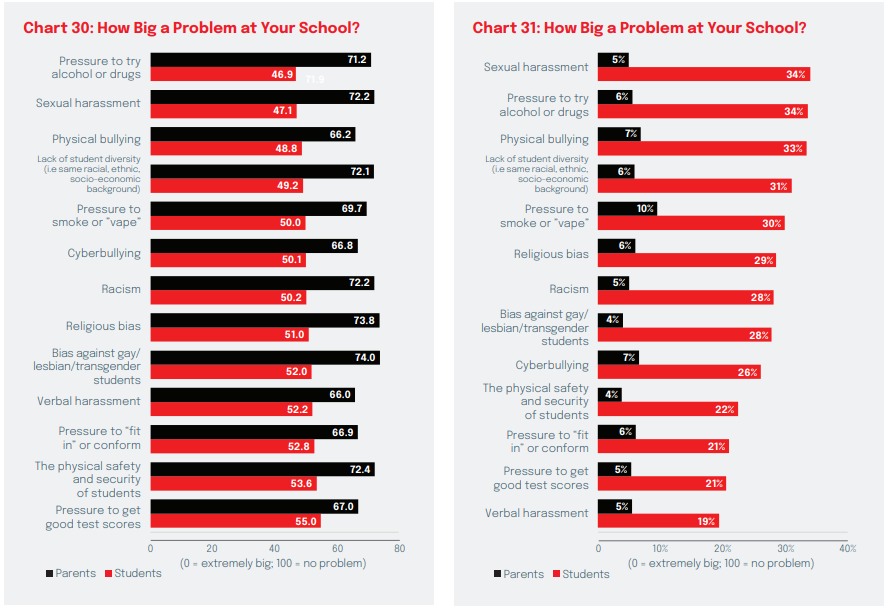
The question of how young people really feel about school is often overshadowed by more quantitative markers, such as test scores or attendance rates. However, understanding how students feel about their educational journey is critical for educators.
Indeed, when principals, teachers and support staff gain a better understanding of students' sentiments, their school's culture, curriculum, and teaching practices, can be enhanced in some truly inspiring ways.
Recognising this, NAB recently launched a nationwide study of 400 students across Years 7-12 to examine their school experience, including their enjoyment at school, start and finish times, the curriculum, skills attained, their teachers, general problems and concerns, and how these can be best addressed.
The findings
The study found boys, in general, enjoy school more than girls, scoring their knowledge of maths, technology, and physical education much higher. Girls, however, believe they have a better grasp of English, the arts, and languages. Boys also believe they are better prepared for the job market or to start and run a business.
Interestingly, a significant difference in self-assessment between students and parents – especially regarding subjects like Arts and Languages – was identified.
Parents rate their children’s reading, writing and expression much higher than students do (74.7 points out of 100 versus 64.7 points). Similarly, on maths and numeracy, parents rated their children more highly than the students rated themselves (73.8 points versus 68 points).
The biggest discrepancy was with arts (68.3 points parents; 57.6 points students) and languages (69.1 points parents; 56.5 points students).
“In many instances, I believe student expectations are simply much higher in some of these areas than those of parents,” Biljana Nikolova, Executive of Government, Education, Community & Indigenous Banking and NAB, told The Educator.
“For example, I doubt many parents would expect their children to be fluent in a chosen language, but they still recognise the benefits these subjects can provide as part of a wider education.”
Student enjoyment was rated broadly similar by type of school. Interestingly, students at girls only schools (61.9 pts) enjoyed school life somewhat more than those at boys only schools (57.5 pts), but boys in general (62.7 pts) more so than girls (56.7 pts). Students in years 7-9 (66.2 pts) also enjoyed school life somewhat more than students in older year groups.
When it comes to what students like most about school, 78% said socialising, followed by studying (32%), teachers/staff (9%), and extracurricular activities. Just 2% of students respectively said they liked opportunities, schedules, and food.
Around 1 in 3 students believe sexual harassment, pressures to try drugs or alcohol, and physical bullying are among the biggest problems at their school, along with a lack of student diversity, pressure to smoke or "vape" (particularly for boys), racism, and bias against gay, lesbian or transgender students or religion. However, far fewer parents identified any of these issues as serious issues for their children.

Most students would prefer a later start and finish time
Australian high schools typically begin between 8:30 to 9:00 AM. However, when students were surveyed regarding their preferred school starting time to optimise learning, the responses varied, with 33% students saying they would choose to start school at the current time and 44% preferring to start later.
Just 22% opted for a 9:30 AM start and another 22% for a 10:00 AM start and 10% said they would prefer the school day to start at 10:30 AM or later.
In contrast, parents' views on school start times were generally more aligned with the current schedule. About 60% of parents believed that the current school start times were optimal for their children, and 25% would prefer a later start for their children. Just 11% suggested a 9:30 AM start and 15% a 10:00 AM start. A mere 3% of parents preferred a school start time of 10:30 AM or later.
How students spend their time
Research shows that the teenage mind functions best when provided with between 9-9½ hours of sleep per night, but according to NAB’s survey, students on average only sleep for 7.3 hours per night.
The survey found little difference in the amount of time spent sleeping by the type of school attended or gender. However, by year level, students in years 7-9 (8.1 hrs) spent somewhat more time asleep than those in years 11 (7.1 hrs) and 12 (7.0 hrs).
Parents, interestingly, underestimate how much time their children sleep - they believe their children sleep over an hour more than they actually do (8.6 hrs). Parents also overestimate how much sleep their children get in all groups, particularly those with children at boys-only schools (8.9 hrs).
Nikolova said lack of sleep is a growing problem for adults and children alike.
“While clearly there is a disconnect between how students are reporting how they spend their time versus parents’ perceptions of this, it’s far from clear as to whether this points to a broader communication issue between parents and adolescents.”
The biggest issues for young people
A considerable number of students identified multiple issues as posing 'extremely' significant problems at their schools:
Approximately 33% of students reported that sexual harassment, pressures to try drugs or alcohol, and physical bullying were major concerns, while 30% highlighted the lack of student diversity, pressure to smoke or "vape" (especially among boys), religious bias, racism, and bias against gay, lesbian, or transgender students as major problems.
Around 20% of students flagged issues such as verbal harassment, pressure to secure good test scores, the need to fit in or conform, and concerns about physical safety and security. A quarter (25%) of students recognised cyberbullying as a significant problem.
In stark contrast, parents perceived these issues as being much less prevalent. The issues ranged from bias against gay, lesbian, or transgender students and concerns about physical safety and security, identified by a mere 4% of all parents, to pressure to smoke or "vape," noted by 10% of parents.
The type of school also influenced student responses.
Students at girls-only and coeducational schools stated that sexual harassment and lack of student diversity were more problematic at their schools (compared to boys-only schools). Students at boys-only and coeducational schools, on the other hand, highlighted cyberbullying and religious bias as bigger issues. At boys-only schools, verbal harassment and pressure to conform stood out.
In general, boys reported the pressure to smoke or "vape" as a much bigger issue than girls did. Notable differences also appeared across year levels: pressure to try alcohol or drugs was a major concern in years 7-9 and year 10, while cyberbullying was flagged as a significant issue in year 12.
The attributes of a great teacher (according to students)
According to the students surveyed, 47% said a great teacher should be “engaging, funny and creative” as opposed to sitting back and lecturing.
However, Nikolova noted that there were subtle differences across student groups canvassed.
“For example, students in boys-only schools said the best teachers created a welcoming learning environment for all students, while those in girls-only schools valued teachers with a positive attitude, who built confidence and motivated them,” Nikolova said.
“Students in years 7-9 said great teachers understood everyone learns differently and at different speeds.”
Approximately 33% of students valued respect, having their ideas and opinions valued, being treated as individuals, empathy, and a welcoming learning environment as crucial qualities in their teachers.
Many students also emphasised the importance of teachers understanding that everyone learns differently and at different paces. Other appreciated qualities included a love of learning, passion for the course material, attention to ensuring each student was making necessary progress, flexibility in teaching methods to make learning more interesting, preparedness and organisation, arriving early to classrooms, and demonstrating patience without rushing students.
For about 30% of parents, the number one quality they sought in a teacher was a positive attitude, the ability to build confidence, and the capacity to motivate their child.
A positive picture overall
Nikolova said overall, the story is a positive one, but there are also a concerning number of students struggling.
“Educators understand this only too well and this is driving increasing pressures on budgets, teachers, and support staff,” Nikolova told The Educator,
“Importantly, three in four Australian high school students believe they are getting a better education than their parents, and score their school life as ‘moderately enjoyable’, at 59.6 pts out of 100. Students also rate their physical health as ‘moderate’ [66.5 points out of 100] and their emotional/mental wellbeing 64.3 out of 100.”
However, it’s important to look beyond the averages, said Nikolova.
“For example, one in five students rated their level of emotional and mental wellbeing as ‘low’, less than 40 out of 100 points. Boys, meanwhile, rated their physical and mental health higher than girls – 70.2 points versus 62.9 points, and 69 points versus 60.1 points,” she said.
“The report also found parents think their children are enjoying their school life much more than students themselves report they are (75.7 points out versus 59.6 points). In boys-only schools the gap is even larger (76.6 points for parents versus 57.5 points for students).”
When it comes to what might explain this phenomenon, Nikolova says time has a significant impact on our memory.
“Like all aspects of life, during our time at school we have both positive and negative thoughts and experiences,” Nikolova said.
“However, these negatives are often short-lived, meaning that over time, people end up forgetting them, which leaves them with a more positive memory of the event. I think this goes a long way to explaining the differences.”
Nikolova said it’s important to note that schools are “at the coal face” when it comes to helping children manage the good and bad times, day to day.
“Wellbeing is a shared responsibility, but increasingly we’ve found schools are being burdened with solving complex – often societal – wellbeing issues,” she said. “While this report isn’t a measure of how ‘fun’ school is, it does give us an insight into what Australian students are feeling and how schools, parents and communities can adapt.”


